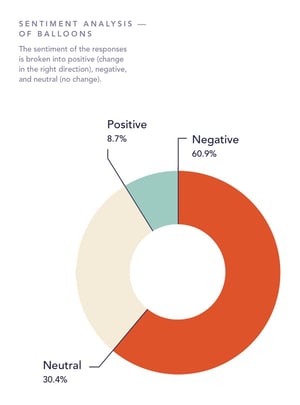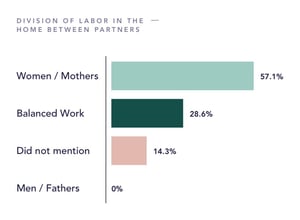The majority of participants, particularly mothers, agree that time management is much more difficult than before as they juggle their careers, families, and mental health, all in the same space—leading to 1 in 10 women reporting plans to leave the workforce.
Background
On September 9, the team at Balloon ran a four-question flight that explored how the COVID-19 pandemic and the widespread transition to remote work and homeschooling has affected working parents. Over the course of two weeks, a variety of people—with children of all ages and careers spanning all industries—shared their thoughts, their experiences, and their stories on Balloon.
Balloon is a collaboration platform that removes harmful group dynamics from discussions, brainstorms, and other group work. Our platform is most often used in professional settings, but it can remove cognitive biases, hierarchy, and fear for all group interactions. Because Balloon’s design streamlines asynchronous collaboration, fosters psychological safety, drives honest contributions, and amplifies unheard voices, the responses surfaced in this flight are precise, human, and true—and they illuminate the difficult, complex realities working parents are navigating in 2020.
Balloon’s mission is to enable teams to harness the power of true insights, no matter where or whom those insights come from.
Balloon uses research-based solutions, including anonymity, flexible timing that allows for asynchronous work, and a unique approval voting system, to drive engagement from every team member—from introverts to loud voices, from interns to CEOs. Balloon’s UX and main process, called a Flight, is specifically designed to mitigate bias and other harmful group dynamics, foster psychological safety, and surface the most innovative ideas from every participant.
Flights, or sets of questions posed by team leaders (“flight creators”), include two stages, which can run for any length of time, avoiding time zones and scheduling conflicts and ensuring all team members can participate.
Stage one—where team members anonymously share ideas, feedback, information, or insights called “balloons”—entirely eliminates anchoring bias. This is a cognitive fallacy in which a group gives undue weight to the first pieces of information shared during a meeting, and all input shared afterwards is discussed in relation to this “anchor.” Additionally, stage one gives participants a much-needed psychologically safe space for everyone to share their input without fear of judgment, interruption, or shame. They can also toggle between Solo and Collaborate modes to comment on others’ responses without the drag of titles, pleasantries, or courtesies, which fundamentally transforms what and how information is discussed.
During stage two, participants evaluate responses—and because they are anonymous, evaluation is based solely on merit. Research in group psychology and decision-making set the foundation for Balloon’s approval voting and decision-making system, in which participants can upvote, or “pump,” as many responses as they like: +1 for balloons they connect to or agree with, and +2 for emphasis. Once the flight is complete, Balloon converts the votes for each piece of feedback into a Balloon Score, or approval ranking, so leaders and their teams can clearly see which ideas are most supported and quickly gauge alignment, offering an unprecedented degree of insight and a way to consistently avoid false starts.
Results
31 participants engaged in the discussion on the following four questions.
Question 1
How has working from home impacted your productivity at work?

The most-supported responses to this question all mentioned a broken work-life balance and shared the sentiment that individual employees have to cover the financial and emotional costs of a tumultuous transition to remote work. The cited costs included working extra, unpaid hours to make up for a workday interrupted by childcare and homeschooling responsibilities, as well as paying for newly necessary hardware and home office supplies like laptops, desks, monitors, and even bigger homes. Although some of the top balloons mentioned some benefits of working from home on productivity, all noted some aspect of adverse effects.
Some responses did express neutral or positive sentiments regarding how remote work has impacted productivity, but 50% of those responses mentioned that they were already working from home before COVID-19.
"Time is MUCH more fragmented. It’s difficult to get into a flow state, and it’s difficult to set aside blocks of time for thinking and strategic work. I’m expending considerable energy on getting breakfast, lunch, and dinner ready for the family, as well as being an assistant teacher and timekeeper for the kids, which leaves little energy for work during the time I have from 9 p.m. to midnight—ugh."
– #1 balloon
"In some ways, it has helped my productivity, as time is not lost to commuting or taking my child to different places. On the other hand, providing education, support, and care for my elementary school-age student is a constant series of interruptions, even with a participatory partner. Days without online school are different, but similarly demanding. The biggest loss is in focus and concentration, unless I work hours outside of the regular work day." – #2 balloon
"Working from home has made me less productive, but not simply because I am at home. (Pre-pandemic, I loved working from home at least one day a week.) Now, I am just so behind in EVERYTHING, and my children are home with me for so much of the time that I am overwhelmed and have a difficult time focusing. It has also been a process that has required precious time and money to try and and a space in our home to dedicate to work. My partner and I have to coordinate our Zoom schedules and decide who gets to use the desk versus who will work on a laptop. It's a nightmare, especially trying to care and monitor virtual school for my small children. I desperately want to be productive. I miss it. It is a huge part of my identity, and it feels like it is lost in all of the chaos, uncertainty, turmoil, stress, and overwhelm." – #3 balloon
"I don't know that my productivity has changed as much as has the length of my workday. I still get the same amount done each day, it just takes me 10 to 12 hours to do it because of the constant distractions and interruptions and redirections." – #4 balloon
"[My productivity has been impacted] a lot. We have three kids, two of whom are in school. Trying to balance working and school without the support from daycare or school itself is very challenging. I'm fortunate in that I can flex my schedule somewhat, but it just means that I've shifted my work to the evenings and nights. Sleep is hard to come by." – #5 balloon
Question 2
What is the single biggest challenge you face as a working parent in 2020?
Echoing the responses from the previous question, nearly all balloons named work-life imbalance as the single biggest challenge. 95% named time management the main contributing factor to this imbalance, and an overlapping 90% further explained that round-the-clock childcare is what makes time management so difficult when working from home.
Expanding on the work-life imbalance, many responses expressed that, pre-pandemic, the physical distinction between work and home helped participants excel in both arenas. Now, as both the professional and personal worlds inhabit the same space, switching between working and parenting mindsets is a huge challenge and reduces cognitive agility, no matter what task they are trying to complete at the moment.
Most responses mentioned several challenges within single responses: More than 50% of responses expressed a decline in mental health due to stress, overwhelm, and lack of space, and 25% expressed a decline in physical health. However, 80% of balloons surrounding physical health gathered very few pumps and fell into the bottom half of approval scores.
"Having enough time to get it all done and still feel like I have enough time for myself. I'm never alone, and it's difficult to know if I'm doing a good enough job with anything—with work, with parenting, with being a good partner, with taking care of myself. When you're isolated in a pandemic, it's easy to lose perspective and community, and I think that lack of connection is the most difficult thing."
– #1 balloon
"Consistent, safe childcare and education. Even if we send our toddler to daycare, it shuts down whenever there is a COVID-positive case, and we are all stuck together again in quarantine. Not to mention the stress of wondering whether we make the right decision to send them and the worry of whether they/we will get sick. The uncertainty is constant, so I feel like I have to be working constantly to counteract the disruptions. The mental drain is not conducive to quality work or productivity." – #2 balloon
"Sharing my space while also being pulled in many different directions at once. Trying to take care of a needy toddler and work at the same time is an enormous challenge in terms of attention and time management. It's also an emotional toll not to have quiet time to concentrate." – #3 balloon
"Not being available 100% of the time, and not being seen as a 'team player' because of it. Also, the constant battle with hiding from my toddler when working." – #4 balloon
Question 3
If you have a partner, how are the responsibilities divided at home? Is your partner putting in as much effort as you are? Please explain your answer.
Regarding a split along gender lines in heterosexual partnerships, more than 57% of participants expressed that the mother and/or wife does more to take care of household responsibilities, including childcare, than their male partner or co-parent.  10% of responses—the authors of which all self-identified as women and mothers—said that they were leaving the workforce to alleviate the workload at home, as their current situations were not sustainable.
10% of responses—the authors of which all self-identified as women and mothers—said that they were leaving the workforce to alleviate the workload at home, as their current situations were not sustainable.


Despite the uneven distribution of household responsibilities between women and men, the qualitative feeling around such distribution was mixed. 61.9% had a neutral sentiment, 23.8% had a negative sentiment or expressed feelings of inequality or resentment, and 14.3% had a positive sentiment.
No responses expressed that the father and/or husband does more to care for the family or home. 28.6% of responses said the division of responsibilities at home were relatively balanced.
Question 4
How has your company supported you since widespread transitions to WFH and homeschooling? Do you think the quality of that experience is influenced by your gender?
More than 75% of participants said their companies have supported them during the transition to remote work and the rise of home- or Zoom-schooling. While responses to the first question noted a lack of financial support from work to pay for newly necessary hardware or home office equipment, these participants expressed that their teams and managers have been understanding of the difficult situation and have implemented helpful policies, like flexible schedules and asynchronous work. However, many respondents expressed worry that their flexible schedules or fragmented hours will have negative impacts on their careers in the long-term.
58% of responses said they do not think their company’s degree of support is influenced by their gender. While no responses explicitly said it is influenced by their gender, many responses implied that it is, while not directly answering the question.
Yes and no. Our team is mostly women, but not everyone has kids. I was the first person whose child's school shut down and did not have a nanny or at-home care. Now that more people have joined in that respect, the company is starting to take these difficulties more seriously and adopt some sort of normalcy towards the availability issue.
– #3 balloon
"I feel supported at an individual level in that I am taking full advantage of our company's workplace flexibility programs, but I'm not sure that everyone at my company feels as comfortable using the programs we have in place. I was granted an arrangement to take two hours in the middle of my day—from 10 a.m. to 12 p.m.— to teach homeschool, and I start my day earlier (and typically end later, too) to make up the hours. This is working well for me so far, and my team has been supportive in scheduling meetings around my two-hour block. In addition to flexible schedules, we also offer employees the option to work part-time to handle childcare related needs. I have heard men are less comfortable asking for these types of arrangements, and that managers may be less likely to proactively offer them. Even though I've been supported in using our programs, I do worry about how this will impact me when it comes time for performance assessment and I'm being rated against my peers, many of whom do not have the same childcare challenges. I worry about perceptions, and don't know yet if this will have a long- term impact on my career." – #4 balloon
